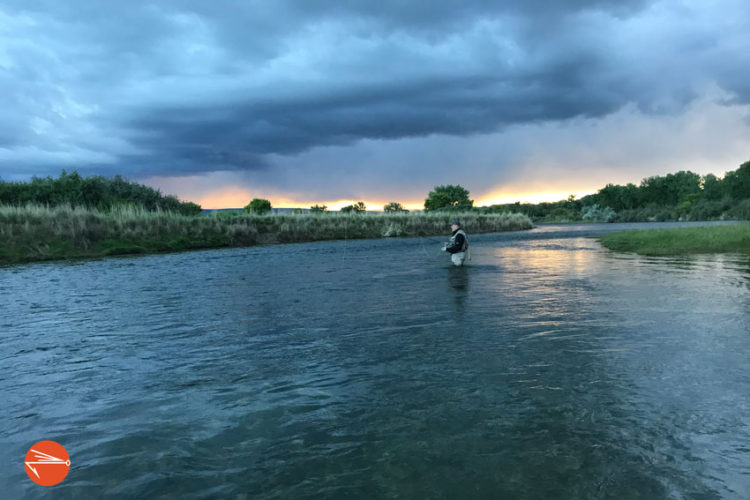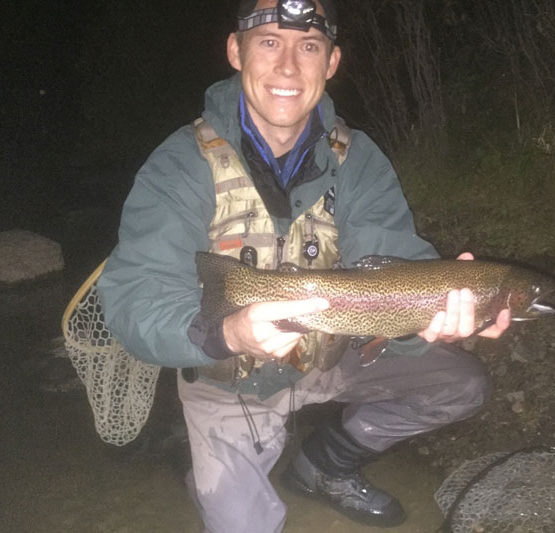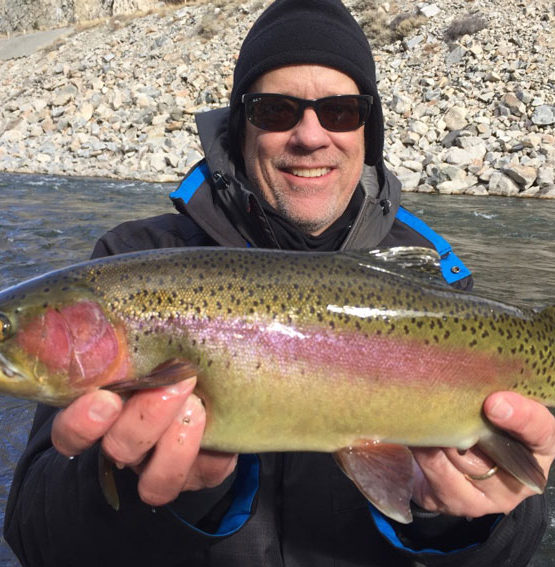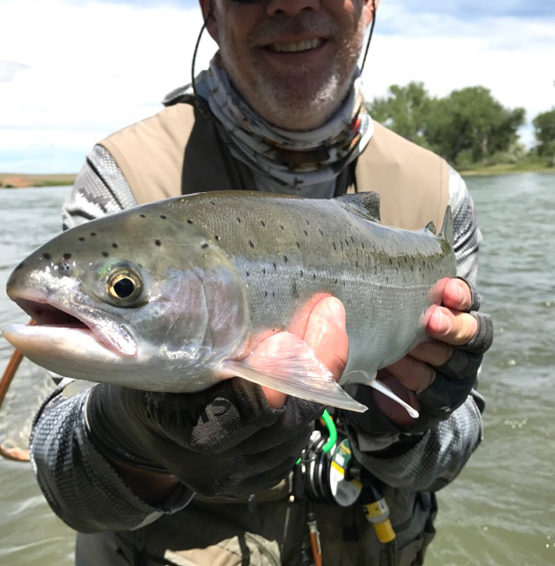For a variety of really great reasons, river fish tend to hang out in riffles and runs. So, if you’re interested in catching more of them, it’s a good idea to learn how to fly fish riffles, big and small, or, if you already know-how, to learn how to do it better. If that’s what you’re looking for, this is an excellent place to start.
In this post, I will describe five easy-to-employ tips and strategies that will help you enjoy more success when fly fishing riffles and runs. Let’s wade in!
Fly Fishing Riffles: The Basics
For the benefit of those in fly fishing education mode, let’s start with a short 101 on riffles and runs. Both provide the fly fisher with a rather easy-to-read surface indicator of the river topography below. In fly fishing parlance, a riffle usually refers to a section of river where smooth flowing water becomes, well, riffly.
Riffles are generated by a sudden change in river structure or flow, for example: a riverbed depression or rise, a bend in the bank, the protrusion of a boulder, or the intrusion of a fallen log.
Similarly, a run usually refers to the length of river that features a surface riffle. Although not universally so, a run is typically spoken of in the context of a deep section of river that, because of its structure, is ideal for holding feeding fish.
To illustrate, I might say to Zach, “Hey buddy, look at that sweet run that starts with the riffle coming around that giant boulder.” To which he might reply, “Dibs!”
So, with that brief overview under our wading belts, let’s jump into some tips for getting more out of those tasty runs.
1. Optimize Your Approach Angle
In a previous article, we went into quite a bit of detail about how to read a river.
As you spy a nice riffle or run you’d like to fish, such knowledge would come in handy, so we encourage you to read that post as well. That said, the long and short of it is that we always recommend taking time to study any section of river you’d like to fish before sloshing in and flailing away.
Take time to consider the following:
Safety
In the words of Clint Eastwood’s famous character, Dirty Harry, “A man’s got to know his limitations.” River current might look rather mild from a distance, but I’ve often found myself in a section of current that is a bit beyond my comfort level, wishing I hadn’t ventured into the run the way I had, and then ruining it with a current-induced stumble, splash-down or worse. Respect the river; look for, and opt for, the safer approach.
Surroundings
Consider things like: potential cast hazards and snags (there’s nothing worse than working your way into a money run only to wind up with a gnarly snag on your first cast); the angle of the sun (casting a shadow across your run is definitely not ideal); from which point in the river will you be able to produce your best drift? (A sweet run will die fast with a few a poorly drifted imitation flies rolling through it.)
Fish Feeding Behavior
Depending upon the way the run is flowing, fish will tend to gravitate to one side of the run or the other. If, while taking a few minutes to observe your targeted stretch of river, you see more risers or flashers on a particular side of the run, take that as a good indicator that more food is flowing on that side, and strategize about how to approach and position for an optimal presentation. By the way, fish feeding lanes can and do change on a moment’s notice, so stay vigilant and proactive.
Landing Zone
Good pool players think as much about the leave as they do the shot. Since a fish caught on a fly isn’t always hooked as well as one caught on a big lure or bait rig, fly fishers put a similar amount of thought into how they plan to play and net a hooked fish before they get to their casting position.
Put another way, the thrill of having a big rainbow on the line will be short lived if you haven’t planned out how you’re going to bring her in. A hooked-but-not-landed fish can be a huge bummer, especially if it’s either the fish of your life or the only one you’ve hooked up on all day.
2. Reduce The Length of Your Cast
Fly fishers are notorious for thinking they can cast a fly the length of a football field and hit a bullseye the size of a dime on the opposite goal line. And while I’ve seen some amazingly accomplished casters who actually can, most of us aren’t that good.
So, when we spot a run we want to work that may be a little too far away; that might be on the other side of a heavy current, or that we simply don’t want to spook, our solution is to attempt the world’s best cast from a bad position. This can work, however, more often than not, a long cast results in an abrupt presentation, a bad drift and messy line management.
If the run you target is just that tasty and yet difficult to reach, as a last resort, I say, go ahead, give it a shot. But before you do, consider a different approach.
Exercise patience. Retreat. Find a safe place to cross the river, and come at the run from the other side, where you will be able to shorten your cast for a better presentation, drift and cleaner line management.
3. Use the High Stick Method
Although, in the right conditions it can work for a dry fly presentation, the high stick method works best when you’re able to get closer to a particular run and when nymphing. This usually means that the river is running with an above average CFS, that the runs are deeper and the fish are less weary of overhead threats.
Building on the shorter cast theme, the high stick method works to keep less of your line on the water in favor of just leader, tippet and fly (or flies).
While attending to good line mending technique, by drawing the tip of your rod up and raising your arm as your fly rig drifts by, the high stick reduces line visibility as it works to mimic subsurface fly emergence behavior.
When other drifting techniques aren’t working, I’ll immediately go to a high stick. Doing so often means the difference between frustration and an all-out festival of fly fishing fun.
4. Go Deeper
One of the most important things you can learn as a fly fisher is proper rig depth. Of course, if you’re working a run with a dry fly or terrestrial setup, depth isn’t going to be much of a consideration.
But, if you’re working a deep run with nymphs, don’t be afraid to add weight and length to your rig. It may be the single best thing you can do to ignite what may seem like a slow run.
Hesitancy to add depth may also be one of the most frequent mistakes we see among newer anglers.
Believe me. I get it. When you’re in a good spot on a choice run getting a good drift, it’s easier to just switch out flies until you, hopefully, find the one or two they like. Changing rig depth (instead of your flies) often feels like it’s going to require more work than you want to do at the moment. Sometimes, however, it’s as simple as adding one more weight and/or adjusting your strike indicator up your leader three or four inches to arrive at the magic rig.
In other words, it’s not your flies that are the problem, it’s your depth.
So, next time you find yourself working a dark and sexy run that feels like it should be producing more action, go deeper!
5. Throw a Quicker Mend
If you want to avoid missed fly fishing opportunities, one of the most important things you can do is mend early.
So, let’s say you’ve worked your way into a perfect position to work a lovely run; that you feel really confident about your rig; that you have a nice clear casting window, and are about ready to make your first cast.
Taking this little fantasy a step further, let’s say that you nail the opener and put your fly on the money, right at the top of the riffle–exactly where you wanted it. Your anticipation soars for an immediate strike but… nothing.
From there, you dutifully mend your rig well through the drift and go about getting ready to cast again, not knowing that the first few feet of your drift happened to be the money zone for the run. If this has happened to you, the problem may have been that you waited too long to throw your first mend.
One of the best techniques I’ve learned over the years — from more accomplished anglers and/or guides — is to place my cast several feet above where the riffle starts and throw an immediate and purposeful upstream mend the instant my rig hits the water. This quick mend action puts my selection of flies into the perfect posture to fool those aggressive feeders who happen to be hammering bugs right as they come into the first foot or two of said riffle.
What’s even better about this quick mending technique is how often I hook up on the beefier trout that populate the run.
Try it. I bet you’ll like it.
Tailing Out
One of my favorite aspects of fly fishing is how physically active and mentally challenging it is. So, whenever I find myself getting lazy or complacent, the conversation I have with myself sounds something like this:
“Matt, get it together man! Get your head back in the game. Tighten up your technique and get back to engaged fly fishing.”(Okay, maybe it’s not that civil but something along those lines.)
If it takes me stepping off the water, grabbing some grub, or sitting down and completely re-rigging for a fresh start, I’ll do it — anything to realign and invigorate my game.
On the other hand, if I feel like my head’s in it but I’m not getting the results I want, I’ll usually find myself working to improve one or more of the tips or techniques described above. And it’s amazing how often a simple and quick adjustment in my approach changes the trajectory of my entire fly fishing day.
Trust me, a hard strike, a good hookup and a fun fight will provide all the invigoration you’ll need.
Tight lines!
Disclaimer: This post may contain affiliate links, meaning we will receive a small commission (at no cost to you) if you click through and make a purchase.










Thanks for the info about fly fishing. I am looking for a new activity to try this year. I’ll consider going on a guided fly fishing trip later this year.